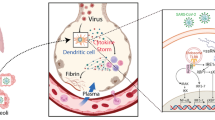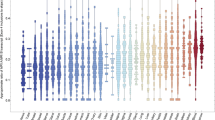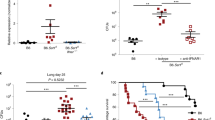Abstract
Interleukin-7 (IL-7) and the IL-7 receptor (IL-7R) have been shown to be alternatively spliced in infectious diseases. We tested IL-7 and IL-7R splicing in a tuberculosis (TB)-vaccine/Mycobacterium tuberculosis (Mtb)-challenge model in non-human primates (NHPs). Differential IL-7 splicing was detected in peripheral blood mononuclear cells (PBMCs) from 15/15 NHPs showing 6 different IL-7 spliced isoforms. This pattern did not change after infection with virulent Mtb. We demonstrated increased IL-7 (6 exon) and IL-17 protein production in lung tissue along with concomitant decreased transforming growth factor-β (TGF-β) from NHPs (vaccinated with a recombinant BCG (rBCG)) who showed increased survival after Mtb challenge. IL-7 increased IL-17 and interferon-γ (IFN-γ) gene and protein expression in PBMCs. Mtb-infected NHPs showed differential IL-7R splicing associated with the anatomical location and tissue origin, that is, in lung tissue, hilus, axillary lymph nodes (LNs) and spleen. Differential splicing of the IL-7R was typical for healthy (non-Mtb infected) and for Mtb-infected lung tissue with a dominant expression of soluble IL-7R (sIL-7R) receptor lacking exon 6 (9:1 ratio of sIL-7R/cell-bound IL-7R). Differential ratios of cell-bound vs sIL-7R could be observed in hilus and axillary LNs from Mtb-infected NHPs with an inversed ratio of 1:9 (sIL-7R/cell-bound IL-7R) in spleen and PBMCs. Soluble IL-7R is exclusively present in lung tissue.
This is a preview of subscription content, access via your institution
Access options
Subscribe to this journal
Receive 6 digital issues and online access to articles
$119.00 per year
only $19.83 per issue
Buy this article
- Purchase on Springer Link
- Instant access to full article PDF
Prices may be subject to local taxes which are calculated during checkout




Similar content being viewed by others
References
Goodwin RG, Lupton S, Schmierer A, Hjerrild KJ, Jerzy R, Clevenger W et al. Human interleukin 7: molecular cloning and growth factor activity on human and murine B-lineage cells. Proc Natl Acad Sci USA 1989; 86: 302–306.
Fry TJ, Mackall CL . The many faces of IL-7: from lymphopoiesis to peripheral T cell maintenance. J Immunol 2005; 174: 6571–6576.
Krawczenko A, Kieda C, Dus D . The biological role and potential therapeutic application of interleukin 7. Arch Immunol Ther Exp (Warsz) 2005; 53: 518–525.
Puel A, Ziegler SF, Buckley RH, Leonard WJ . Defective IL7R expression in T(−)B(+)NK(+) severe combined immunodeficiency. Nat Genet 1998; 20: 394–397.
Giliani S, Mori L, de Saint Basile G, Le Deist F, Rodriguez-Perez C, Forino C et al. Interleukin-7 receptor alpha (IL-7Ralpha) deficiency: cellular and molecular bases. Analysis of clinical, immunological, and molecular features in 16 novel patients. Immunol Rev 2005; 203: 110–126.
Korte A, Moricke A, Beyermann B, Kochling J, Taube T, Kebelmann-Betzing C et al. Extensive alternative splicing of interleukin-7 in malignant hematopoietic cells: implication of distinct isoforms in modulating IL-7 activity. J Interferon Cytokine Res 1999; 19: 495–503.
Vudattu NK, Magalhaes I, Hoehn H, Pan D, Maeurer MJ . Expression analysis and functional activity of interleukin-7 splice variants. Genes Immun 2009; 10: 132–140.
Rane L, Vudattu N, Bourcier K, Graniar E, Hillert J, Seyfert V et al. Alternative splicing of interleukin-7 (IL-7) and interleukin-7 receptor alpha (IL-7Ralpha) in peripheral blood from patients with multiple sclerosis (MS). J Neuroimmunol 2010; 222: 82–86.
Frishman J, Long B, Knospe W, Gregory S, Plate J . Genes for interleukin 7 are transcribed in leukemic cell subsets of individuals with chronic lymphocytic leukemia. J Exp Med 1993; 177: 955–964.
Moors M, Vudattu NK, Abel J, Kramer U, Rane L, Ulfig N et al. Interleukin-7 (IL-7) and IL-7 splice variants affect differentiation of human neural progenitor cells. Genes Immun 2010; 11: 11–20.
Booth DR, Arthur AT, Teutsch SM, Bye C, Rubio J, Armati PJ et al. Gene expression and genotyping studies implicate the interleukin 7 receptor in the pathogenesis of primary progressive multiple sclerosis. J Mol Med 2005; 83: 822–830.
Gregory SG, Schmidt S, Seth P, Oksenberg JR, Hart J, Prokop A et al. Interleukin 7 receptor alpha chain (IL7R) shows allelic and functional association with multiple sclerosis. Nat Genet 2007; 39: 1083–1091.
Lundmark F, Duvefelt K, Iacobaeus E, Kockum I, Wallstrom E, Khademi M et al. Variation in interleukin 7 receptor alpha chain (IL7R) influences risk of multiple sclerosis. Nat Genet 2007; 39: 1108–1113.
Ahlers JD, Belyakov IM . Memories that last forever: strategies for optimizing vaccine T-cell memory. Blood 2010; 115: 1678–1689.
Jiang Q, Li WQ, Aiello FB, Mazzucchelli R, Asefa B, Khaled AR et al. Cell biology of IL-7, a key lymphotrophin. Cytokine Growth Factor Rev 2005; 16: 513–533.
Maeurer MJ, Trinder P, Hommel G, Walter W, Freitag K, Atkins D et al. Interleukin-7 or interleukin-15 enhances survival of Mycobacterium tuberculosis-infected mice. Infect Immun 2000; 68: 2962–2970.
Sudo T, Nishikawa S, Ohno N, Akiyama N, Tamakoshi M, Yoshida H . Expression and function of the interleukin 7 receptor in murine lymphocytes. Proc Natl Acad Sci USA 1993; 90: 9125–9129.
Armitage RJ, Ziegler SF, Beckmann MP, Idzerda RL, Park LS, Fanslow WC . Expression of receptors for interleukin 4 and interleukin 7 on human T cells. Adv Exp Med Biol 1991; 292: 121–130.
Noguchi M, Nakamura Y, Russell SM, Ziegler SF, Tsang M, Cao X et al. Interleukin-2 receptor gamma chain: a functional component of the interleukin-7 receptor. Science 1993; 262: 1877–1880.
Leonard WJ . TSLP: finally in the limelight. Nat Immunol 2002; 3: 605–607.
Rose T, Lambotte O, Pallier C, Delfraissy JF, Colle JH . Identification and biochemical characterization of human plasma soluble IL-7R: lower concentrations in HIV-1-infected patients. J Immunol 2009; 182: 7389–7397.
Crawley AM, Faucher S, Angel JB . Soluble IL-7R alpha (sCD127) inhibits IL-7 activity and is increased in HIV infection. J Immunol 2010; 184: 4679–4687.
Sahoo A, Im SH . Interleukin and interleukin receptor diversity: role of alternative splicing. Int Rev Immunol 2010; 29: 77–109.
Djoba Siawaya JF, Bapela NB, Ronacher K, Beyers N, van Helden P, Walzl G . Differential expression of interleukin-4 (IL-4) and IL-4 delta 2 mRNA, but not transforming growth factor beta (TGF-beta), TGF-beta RII, Foxp3, gamma interferon, T-bet, or GATA-3 mRNA, in patients with fast and slow responses to antituberculosis treatment. Clin Vaccine Immunol 2008; 15: 1165–1170.
Atamas SP, Choi J, Yurovsky VV, White B . An alternative splice variant of human IL-4, IL-4 delta 2, inhibits IL-4-stimulated T cell proliferation. J Immunol 1996; 156: 435–441.
Arinobu Y, Atamas SP, Otsuka T, Niiro H, Yamaoka K, Mitsuyasu H et al. Antagonistic effects of an alternative splice variant of human IL-4, IL-4delta2, on IL-4 activities in human monocytes and B cells. Cell Immunol 1999; 191: 161–167.
Nishikubo K, Murata Y, Tamaki S, Sugama K, Imanaka-Yoshida K, Yuda N et al. A single administration of interleukin-4 antagonistic mutant DNA inhibits allergic airway inflammation in a mouse model of asthma. Gene Ther 2003; 10: 2119–2125.
Dheda K, Chang JS, Breen RA, Kim LU, Haddock JA, Huggett JF et al. In vivo and in vitro studies of a novel cytokine, interleukin 4delta2, in pulmonary tuberculosis. Am J Respir Crit Care Med 2005; 172: 501–508.
Lurquin C, Lethe B, De Plaen E, Corbiere V, Theate I, van Baren N et al. Contrasting frequencies of antitumor and anti-vaccine T cells in metastases of a melanoma patient vaccinated with a MAGE tumor antigen. J Exp Med 2005; 201: 249–257.
Corbiere V, Chapiro J, Stroobant V, Ma W, Lurquin C, Lethe B et al. Antigen spreading contributes to MAGE vaccination-induced regression of melanoma metastases. Cancer Res 2011; 71: 1253–1262.
Magalhaes I, Vudattu NK, Jager E, Maeurer MJ . Tumor antigen-specific T-cells are present in the CD8alphaalpha+ T-cell effector-memory pool. J Immunother 2008; 31: 840–848.
Magalhaes I, Vudattu NK, Ahmed RK, Kuhlmann-Berenzon S, Ngo Y, Sizemore DR et al. High content cellular immune profiling reveals differences between rhesus monkeys and men. Immunology 2010; 131: 128–140.
Madakamutil LT, Christen U, Lena CJ, Wang-Zhu Y, Attinger A, Sundarrajan M et al. CD8alphaalpha-mediated survival and differentiation of CD8 memory T cell precursors. Science 2004; 304: 590–593.
Boulassel MR, Mercier F, Gilmore N, Routy JP . Immunophenotypic patterns of CD8+ T cell subsets expressing CD8alphaalpha and IL-7Ralpha in viremic, aviremic and slow progressor HIV-1-infected subjects. Clin Immunol 2007; 124: 149–157.
Liu W, Putnam AL, Xu-Yu Z, Szot GL, Lee MR, Zhu S et al. CD127 expression inversely correlates with FoxP3 and suppressive function of human CD4+ T reg cells. J Exp Med 2006; 203: 1701–1711.
Seddiki N, Santner-Nanan B, Martinson J, Zaunders J, Sasson S, Landay A et al. Expression of interleukin (IL)-2 and IL-7 receptors discriminates between human regulatory and activated T cells. J Exp Med 2006; 203: 1693–1700.
Pellegrini M, Calzascia T, Elford AR, Shahinian A, Lin AE, Dissanayake D et al. Adjuvant IL-7 antagonizes multiple cellular and molecular inhibitory networks to enhance immunotherapies. Nat Med 2009; 15: 528–536.
Huang M, Sharma S, Zhu LX, Keane MP, Luo J, Zhang L et al. IL-7 inhibits fibroblast TGF-beta production and signaling in pulmonary fibrosis. J Clin Invest 2002; 109: 931–937.
Chapman HA . Disorders of lung matrix remodeling. J Clin Invest 2004; 113: 148–157.
Hall CH, Kassel R, Tacke RS, Hahn YS . HCV+ hepatocytes induce human regulatory CD4+ T cells through the production of TGF-beta. PLoS One 2010; 5: e12154.
Walline CC, Kanakasabai S, Bright JJ . IL-7Ralpha confers susceptibility to experimental autoimmune encephalomyelitis. Genes Immun 2010; 12: 1–14.
Wozniak TM, Saunders BM, Ryan AA, Britton WJ . Mycobacterium bovis BCG-specific Th17 cells confer partial protection against Mycobacterium tuberculosis infection in the absence of gamma interferon. Infect Immun 2010; 78: 4187–4194.
Okamoto Yoshida Y, Umemura M, Yahagi A, O’Brien RL, Ikuta K, Kishihara K et al. Essential role of IL-17A in the formation of a mycobacterial infection-induced granuloma in the lung. J Immunol 2010; 184: 4414–4422.
Oshima S, Nakamura T, Namiki S, Okada E, Tsuchiya K, Okamoto R et al. Interferon regulatory factor 1 (IRF-1) and IRF-2 distinctively up-regulate gene expression and production of interleukin-7 in human intestinal epithelial cells. Mol Cell Biol 2004; 24: 6298–6310.
Trinder P, Seitzer U, Gerdes J, Seliger B, Maeurer M . Constitutive and IFN-gamma regulated expression of IL-7 and IL-15 in human renal cell cancer. Int J Oncol 1999; 14: 23–31.
Desvignes L, Ernst JD . Interferon-gamma-responsive nonhematopoietic cells regulate the immune response to Mycobacterium tuberculosis. Immunity 2009; 31: 974–985.
Calzascia T, Pellegrini M, Lin A, Garza KM, Elford AR, Shahinian A et al. CD4T cells, lymphopenia, and IL-7 in a multistep pathway to autoimmunity. Proc Natl Acad Sci USA 2008; 105: 2999–3004.
Benjamin D, Sharma V, Knobloch TJ, Armitage RJ, Dayton MA, Goodwin RG . B cell IL-7. Human B cell lines constitutively secrete IL-7 and express IL-7 receptors. J Immunol 1994; 152: 4749–4757.
Kroncke R, Loppnow H, Flad HD, Gerdes J . Human follicular dendritic cells and vascular cells produce interleukin-7: a potential role for interleukin-7 in the germinal center reaction. Eur J Immunol 1996; 26: 2541–2544.
Hoe E, McKay FC, Schibeci SD, Gandhi K, Heard RN, Stewart GJ et al. Functionally significant differences in expression of disease-associated IL-7 receptor alpha haplotypes in CD4T cells and dendritic cells. J Immunol 2010; 184: 2512–2517.
Magalhaes I, Sizemore DR, Ahmed RK, Mueller S, Wehlin L, Scanga C et al. rBCG induces strong antigen-specific T cell responses in rhesus macaques in a prime-boost setting with an adenovirus 35 tuberculosis vaccine vector. PLoS One 2008; 3: e3790.
Acknowledgements
The study has been supported by VR, Vinnova, HLF, Sweden and the Aeras foundation, USA to MM, Lalit Rane received a KID grant from KI, Sweden.
Author information
Authors and Affiliations
Corresponding author
Ethics declarations
Competing interests
The authors declare no conflict of interest.
Additional information
Supplementary Information accompanies the paper on Genes and Immunity website
Supplementary information
Rights and permissions
About this article
Cite this article
Rane, L., Rahman, S., Magalhaes, I. et al. Increased (6 exon) interleukin-7 production after M. tuberculosis infection and soluble interleukin-7 receptor expression in lung tissue. Genes Immun 12, 513–522 (2011). https://doi.org/10.1038/gene.2011.29
Received:
Revised:
Accepted:
Published:
Issue Date:
DOI: https://doi.org/10.1038/gene.2011.29
Keywords
This article is cited by
-
Mycobacterium tuberculosis co-infection is associated with increased surrogate marker of the HIV reservoir
AIDS Research and Therapy (2020)
-
Th1 cytokines, true functional signatures for protective immunity against TB?
Cellular & Molecular Immunology (2018)



